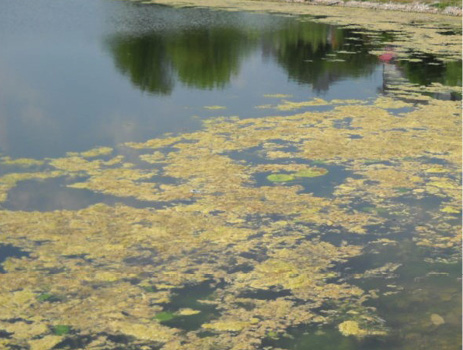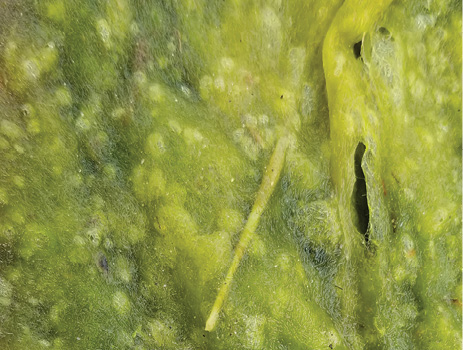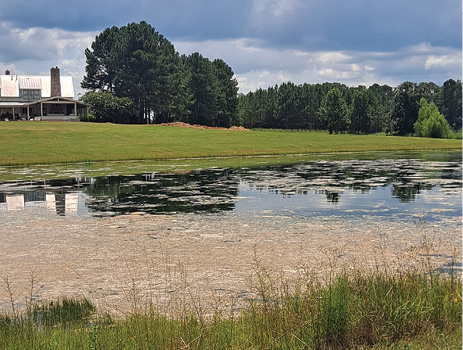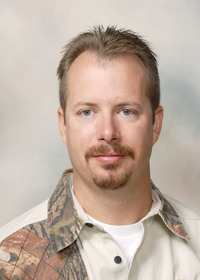Filamentous Algae | Including Colonial Forms
Algae | Native

may look like balls of cotton.


bloom in the spring.
Colonial algae have a variety of forms, ranging from thin, fragile filaments or nets to large, gelatinous “blobs.” Four common genera are Pithophora, Lyngbya, Hydrodictyon, and Spirogyra.
Pithophora
Pithophora is an alga that forms major surface infestations made up of small to medium colonies that resemble dark to lime green cotton balls. Its filaments are large and distinguishable but, unlike other algae, are difficult to tear apart and coarse to the touch. Pithophora is most common in spring and summer but may persist year-round.
Lyngbya
Mats of this cyanobacteria are typically black in the spring, becoming mottled (black, brown, green, and white) in late summer and fall. Extensive mats on pond bottoms persist during all seasons, making Lyngbya difficult to control. Blooms (population explosion) occur in elevated calcium or phosphorus levels. Lyngbya has a strong musty odor and coarse filaments. It is known to produce neurotoxins capable of killing fish, livestock, and pets.
Hydrodictyon
This green alga may form surface colonies that appear frothy and medium to pale green. Mats readily break apart when handled. Blooms occur in protected hard-water environments with elevated nutrient levels, typically during midsummer. Close inspection of Hydrodictyon reveals a fine, net-like structure.
Spirogyra
This green alga forms bottom and surface mats that are initially bright green, then fade to yellow in the summer. Individual strands of Spirogyra run parallel and have a smooth, silky feel.
Management Value
None. Filamentous algae do not significantly add to the food web and can quickly reach problematic levels. Blooms should be dealt with swiftly upon identification.
Recommended Controls
Treatment is based on acre-feet or surface area. Acre-feet is calculated as average depth multiplied by surface acres. Most Mississippi ponds average about 5 to 6 feet deep and have 5 to 6 acre-feet per surface acre. For surface area, use the area of the whole pond, not just the area of plant coverage.
Species other than Pithophora or Lyngbya: Chelated copper complexes. Use 1.5 gallons of chelated copper (0.9-pound formulation) per acre-foot. Determine pond volume prior to algaecide application. Dilute each part of chelated copper with 9 parts water and spray to wet all surface mats. Injection (subsurface application using a wand or hose) of diluted liquid chelated copper or broadcasting granulated chelated copper can be used to kill algae growing on the pond bottom. Granular rate is 1 pound per 720 square feet or 60 pounds per surface acre. Copper can be toxic to fish when water alkalinity is low. Do not use copper in catfish or koi ponds when alkalinity is less than 50 ppm. Do not exceed annual herbicide rate limits as stated on the product label.
For Pithophora: Mix 1 gallon of chelated copper liquid (0.9-pound formulation), 1 gallon of diquat (3.73-pound formulation), and 9 gallons of water for each acre-foot to be treated and spray to wet all surface mats. Determine pond volume prior to algaecide application. Injection (subsurface application using a wand or hose) of the mix above or broadcasting granulated chelated copper can be used to kill algae growing on the pond bottom. Granular rate is 1 pound per 720 square feet or 60 pounds per surface acre. Copper can be toxic to fish when water alkalinity is low. Do not use copper in catfish or koi ponds when alkalinity is less than 50 ppm. Do not exceed annual herbicide rate limits as stated on the product label.
NOTE: Acre-foot = average depth of pond multiplied by pond acreage; average depth is calculated by taking the depth at 20 points across a water body and averaging the values.
For Lyngbya: Apply peroxide (e.g., Phycomycin) at a rate of 75 pounds per treated surface acre. Wait 48–72 hours for the Lyngbya mat to detach from the lakebed and float to the surface. Once the mat detaches, apply a chelated copper compound containing D-limonene (e.g., Cutrine-Ultra) to the surface of the waterbody at 2 gallons per surface acre.
Apply on sunny days when water temperature is above 60°F. Use of copper when alkalinity is less than 50 ppm may kill fish. For heavy blooms, treat only one-third of the pond at a time during the early morning hours. Wait 1 week between treatments of filamentous algae.
Read and follow all chemical label instructions, especially the section on the use of personal protection equipment.

The information given here is for educational purposes only. References to commercial products, trade names, or suppliers are made with the understanding that no endorsement is implied and that no discrimination against other products or suppliers is intended.
Publication 3735-1 (POD-09-23)
By Wes Neal, PhD, Extension/Research Professor, Wildlife, Fisheries, and Aquaculture; Dennis Riecke, Fisheries Coordinator, Mississippi Department of Wildlife, Fisheries, and Parks; and Gray Turnage, PhD, Assistant Research/Extension Professor, GeoSystems Research Institute.
The Mississippi State University Extension Service is working to ensure all web content is accessible to all users. If you need assistance accessing any of our content, please email the webteam or call 662-325-2262.



